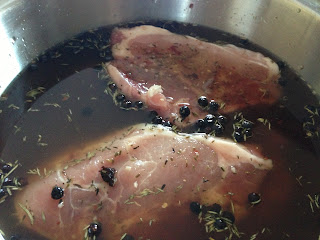Rachael from pizzarossa was our lovely June 2013 Daring Bakers’ host and she had us whipping up delicious pies in our kitchens! Cream pies, fruit pies, chocolate pies, even crack pies! There’s nothing like pie! :)
I knew this month would be a "must-do" because, as I'm sure I've mentioned before, my husband loves pie. Wanted wedding pies instead of a wedding cake kind of love for pie. I've also been wanting to experiment with different pie crusts because I haven't quite found that one recipe that I really like as my go-to. When I was looking through the 4 different recipes Rachael provided, I was intrigued by the crostata. I am always looking for a use for my tart pan and the idea of using fresh summer fruits as a filling really sounded great. I used peaches, plums and blueberries in my crostata, although you can use any combination of fruits or jams that you like! I love a flexible recipe.
When I was making the dough I was so pleased with the fresh smell from the lemon zest and the wonderful texture as I rolled it out. This is a great dough recipe! The only issue I ran into was that my tart pan is a bit bigger than the original recipe called for, so I didn't have quite enough to make the lattice top look great. That could also be due to me being a little lazy with the rolling and cutting and actually putting the lattice pieces on. Either way, I'll definitely be using this dough recipe again!
A quick update on project babies: At the writing of this post, we are 37 weeks into the pregnancy. By the time this gets posted, we will be one day away from holding our two little ones in our arms (or will have had them already! crazy thought!) Now that school is finished for the summer and I am just waiting for labor to begin at any moment, I find myself planning kitchen projects that are a bit more optimistic than the realities of my physical situation will allow. This was a great, simple project that I could handle, even when I can barely reach the counter due to my giant stomach being in the way. I can't roll out dough without having a line of flour on my shirt, nor can I wash dishes by hand without also giving the front of whatever I am wearing a good soaking as well. I don't mind too much, and the babies must be getting lots of happy endorphins from me being in the kitchen, because they are always dancing around when I'm happily cooking away.
Stone Fruit Crostata (filling adapted from Ina Garten's Summer Fruit Crostata )
Ingredients:
Pasta Frolla (basic Italian pie pastry)
2/3 cup unsalted butter, room temperature
1/3 cup sugar
1 large egg, room temperature
1 teaspoon vanilla extract
grated zest of 1 medium lemon
1-2/3 cups all-purpose (plain) flour
pinch salt
Fruit Filling
1 pint blueberries
1 lb firm peaches (peeled)
1/2 lb firm black plums
1 tbs flour
1 tbs sugar
2 tbs orange juice
Pastry
1. Using a paddle attachment on a stand mixer or an electric hand mixer or whisk, cream the butter and sugar until pale and fluffy, 2 -5 minutes. The amount of time you cream the butter will affect the final
dough - longer means lighter which in turn means a softer, more fragile dough which is less easy to work, but I prefer the texture of the cooked pastry this way because it's lighter too. If you want to do a more intricate lattice, I'd recommend a shorter creaming time so you have a firmer dough.
2. Add the egg, vanilla and lemon zest, one at a time, mixing thoroughly after each addition.
3. Add the flour and salt and mix until the dough comes together but remains soft, about 1 minute using a stand or electric mixer or a wooden spoon if mixing by hand. Don't over-mix.
4. Wrap dough in plastic wrap and refrigerate for 30 minutes to one hour. When getting ready to bake, rest dough at room temperature for about 30 minutes.
5. Lightly grease a shallow metal pie or tart pan. On either a piece of parchment or a lightly floured surface, roll 2/3 of the dough out to a circle to generously line the pie dish.
6. Transfer the dough to the pie dish, press in gently and roll the edges to form a good surface for attaching the lattice later. Prick all over the bottom with a fork.
7. Refrigerate the dough-lined pie dish for 30 minutes to reduce shrinkage during baking. Preheat oven to moderate 350°F.
8. Line pastry with parchment and fill with dry beans or pie weights. Bake until set, around 15 minutes.
9. Remove the weights and parchment and allow to cool. If using a springform or loose based pie dish, remove the side of the pan.
10. Preheat oven to moderately hot 400°F. Roll the remaining dough to fit the pie dish and cut it into roughly half inch wide strips.
11. Spread the filling over the par-baked crust. Arrange the strips of dough in a lattice over the filling, trim as needed and lightly pinch the ends onto the rolled edge of the bottom crust.
12. Place pie dish on a baking sheet and place in center of oven. Bake until lattice is golden, around 20 minutes.
Filling
1. Cut the peaches and plums in wedges and place them in a bowl with the blueberries. Toss them with 1 tablespoon of the flour, 1 tablespoon of the sugar, and the orange juice. (that's it. simple, right?!)

















